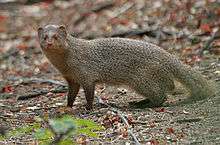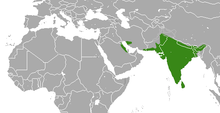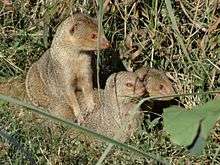Indian grey mongoose
| Indian grey mongoose | |
|---|---|
 | |
| Adult in the wild (Hyderabad, India) | |
| Scientific classification | |
| Kingdom: | Animalia |
| Phylum: | Chordata |
| Class: | Mammalia |
| Order: | Carnivora |
| Family: | Herpestidae |
| Subfamily: | Herpestinae |
| Genus: | Herpestes |
| Species: | H. edwardsi |
| Binomial name | |
| Herpestes edwardsi É. Geoffroy Saint-Hilaire, 1818 | |
 | |
| Indian grey mongoose range | |
The Indian grey mongoose or common grey mongoose (Herpestes edwardsi) is a mongoose species mainly found in West Asia and on the Indian subcontinent.[1] In North Indian languages (Hindi/Punjabi) it is called Nevlaa. The grey mongoose is commonly found in open forests, scrublands and cultivated fields, often close to human habitation. It lives in burrows, hedgerows and thickets, among groves of trees, and takes shelter under rocks or bushes and even in drains. It is very bold and inquisitive but wary, seldom venturing far from cover. It climbs very well. Usually found singly or in pairs. It preys on rodents, snakes, birds’ eggs and hatchlings, lizards and variety of invertebrates. Along the Chambal River it occasionally feeds on gharial eggs. It breeds throughout the year.
Characteristics
The Indian grey mongoose has tawny grey or iron grey fur, which is more grizzled and stiffer and coarser than that of other mongooses. The ruddiness of the coat varies in different subspecies, but it is described as appearing more grey than other mongooses. The grizzled appearance comes from the individual hairs being ringed by creamy-white and black. The legs are brown and darker than the body. The hair around the muzzle and eyes is also brown but with a stronger rusty red colouring. The tail is bushy, whilst the tip of the tail, if coloured, is pale yellow or white.[2][3][4]
Their tail length equals their body length. Body length: 36–45 cm (14-17 inches) Tail length: 45 cm (17 inches), weight: 0.9-1.7 kg (2-4 lb). Males are significantly larger than the females. Indian grey mongooses are unusual in that they can discriminate four colours, more than most other mammals.[5]
Distribution and habitat
It has been generally accepted that the Indian grey mongoose occurs in Saudi Arabia, Kuwait, Bahrain, Iran, Afghanistan, Pakistan, India, Nepal, Sri Lanka, and Bangladesh, as represented by the distribution map.[1][6][7] A 2007 study found specimens also in Turkey, and United Arab Emirates, thus extending the known range.[8]
Despite being a common animal, the natural history of the Indian grey mongoose is not well known.[1] They appear to be able to occupy a wide variety of habitats but preferring open types. These include grasslands, open areas, rocky patches, scrub, semi-desert, cultivated fields and other disturbed areas, areas of thickets, bushy vegetation, dry secondary forest, thorn forest, forest edges, and also near human settlement.[3][4][9] Although the creature has been described as being less dependent on human settlements, observations in India in heavily forested areas show it to be much more common around human settlements often scavenging on waste.[10]
Ecology and behaviour
The Indian grey mongoose is omnivorous, though most of its diet is made up from live prey it catches from being an opportunistic hunter, with mice, rats, lizards, snakes, and beetles making up the bulk. Also eaten are ground birds, their eggs, grasshoppers, scorpions, centipedes, frogs, crabs, fish, and parts of plants: fruits, berries, and roots, as well as larger prey including hares and egrets.[11] It kills prey by delivering a bite to the neck or head.

This species is known for its ability to combat venomous snakes. It primarily achieves this through tiring the snake out, by enticing it to make multiple strikes which it acrobatically avoids.[2][11] Secondary protection against the venomous bite includes the stiff rigid hair, which is excited at such times, the thick loose skin and specialised acetylcholine receptors render it resistant or immune to snake venom.[12] When dealing with scorpions, no measures are taken to disable the sting, and they are picked up in any manner.[13]
The Indian grey mongoose typically opens eggs by holding them between the paws and biting a hole in the little end.[13] Smaller mongooses typically open eggs by throwing them between their legs against a hard object, so it has been speculated,[13] that the adult Indian grey mongoose should do likewise with large eggs.

The Indian grey mongoose mates between March and October, it breeding two to three times each year. The gestation period lasts for 60 to 65 days, the female gives birth to two to four offsprings.[11]
The lifespan of the Indian grey mongoose is seven years in the wild, or 12 years, when in captivity.[11]
Relation with humans
The Indian grey mongoose often is kept as a pet to keep dwellings free from rats and other pests.[14]
The Indian grey mongoose is the state animal of Chandigarh.[15]
-_is_it-_at_Hyderabad%2C_AP_W_106.jpg) Grey mongoose photographed in Hyderabad, India.
Grey mongoose photographed in Hyderabad, India.
-_is_it-_at_Hyderabad%2C_AP_W_101.jpg) in Hyderabad, India.
in Hyderabad, India. Baby mongooses in Chennai, India
Baby mongooses in Chennai, India
References
- 1 2 3 4 Mudappa, D. & .; Choudhury, A. (2016). "Herpestes edwardsii". IUCN Red List of Threatened Species. Version 2016.2. International Union for Conservation of Nature.
- 1 2 Sterndale, Robert A. (1884). "No. 236 Herpestes Pallidus vel Griseus The Common Grey Mungoose". Natural history of the Mammalia of India and Ceylon. Calcutta: Thacker, Spink.
- 1 2 Hussain, Riaz; Mahmood, Tariq (20 October 2016). "Comparative Ecology of Two Sympatric Mongoose Species (Herpestes javanicus and H. edwardsii) in Pothwar Plateau, Pakistan." (PDF). Pakistan Journal of Zoology. 48 (6): 1931–1943. Retrieved 2 January 2017.
- 1 2 Menon, Vivek (2014). Indian Mammals: A Field Guide. Gurgaon: Hatchet Book Publishing India. ISBN 978-93-5009-761-8.
- ↑ Ewer, R. F. (1973). The carnivores. London: Weidenfeld and Nicolson. pp. 124–125. ISBN 0297995642.
- ↑ Hinton, H. E.; Dunn, A. M. S. (1967). Mongooses. Their Natural History and Behaviour. Los Angeles: University of California Press. p. 117.
- ↑ Sharma, Gaurav; Kamalakannan, M.; Venkataraman, K. (1 July 2015). A checklist of mammals of India with their distribution and conservation status (PDF). Kolkata: Govt. of India.
- ↑ Veron, G., Patou, M.-L., Pothet, G., Simberloff, D. and Jennings, A.P. (2007). Systematic status and biogeography of the Javan and Small Indian Mongooses (Herpestidae, Carnivora). Zoologica Scripta 36: 1–10.
- ↑ Duff, Andrew; Lawson, Ann (2004). Mammals of the World: A Checklist. New Haven and London: Yale University Press. p. 117. ISBN 0-300-10398-0.
- ↑ Shekhar, K. S. (October 2003). "The status of mongooses in central India.". Small Carnivore Conservation. 29: 22–24. Retrieved 5 January 2017.
- 1 2 3 4 Graham, E. (2004). "Herpestes edwardsi Indian grey mongoose". Animal Diversity Web. University of Michigan. Retrieved 23 December 2016.
- ↑ "How the Mongoose Defeats the Snake". Retrieved 2010-10-25.
- 1 2 3 Ewer, R. F. (1973). The carnivores. London: Weidenfeld and Nicolson. p. 198-200. ISBN 0297995642.
- ↑ Lal, Ranjit (20 September 2015). "Mongooses are fierce hunters as well as great pets". The Indian Express. New Delhi. Retrieved 23 December 2016.
- ↑ "State Animal, Bird, Tree and Flower of Chandigarh" (PDF). Department of Forests & Wildlife. Chandigarh Administration. Retrieved 12 January 2017.
